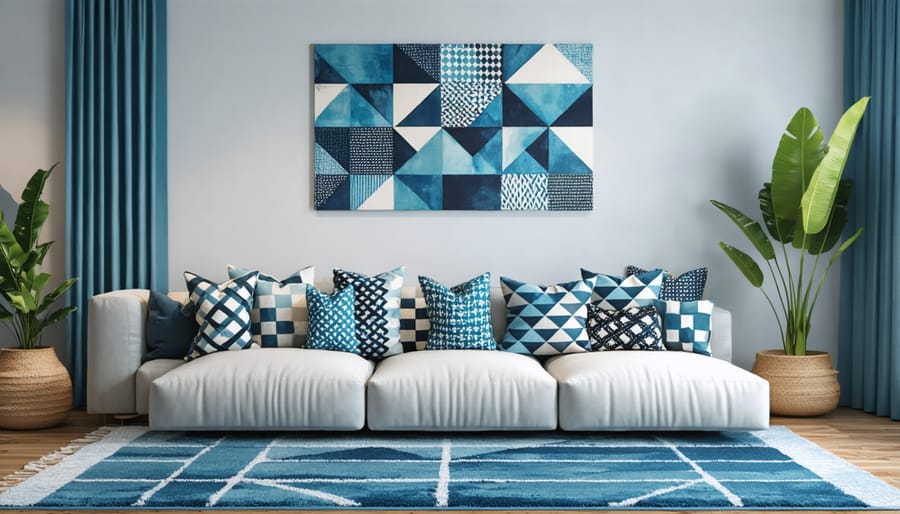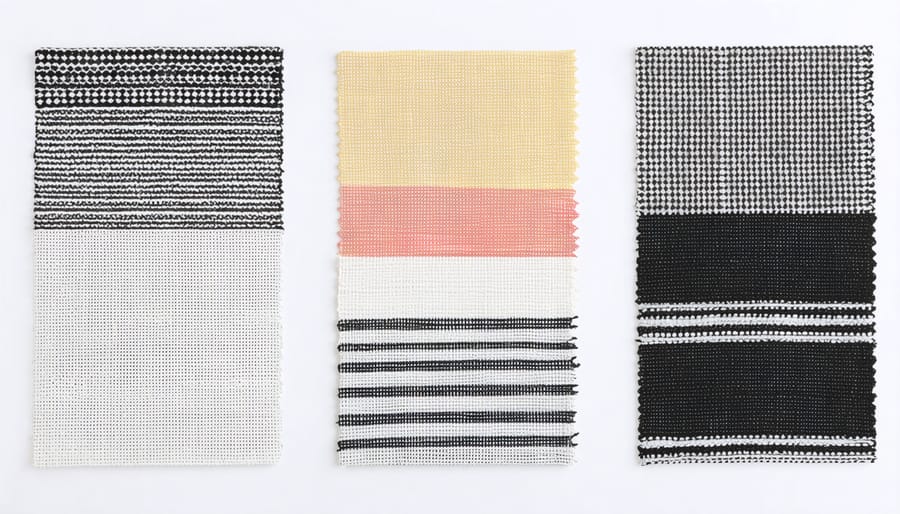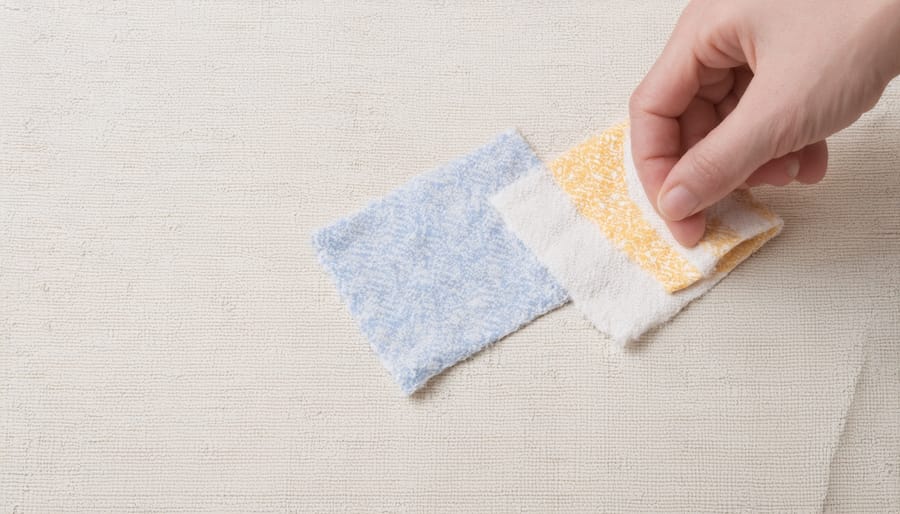Transform your living spaces by mastering textile patterns – nature’s most powerful design language. Understanding how patterns interact forms the foundation of essential interior design principles, turning ordinary rooms into extraordinary experiences. From the subtle rhythm of herringbone to the bold statements of geometric prints, patterns tell stories, create depth, and establish mood in ways that solid colors simply cannot match.
Start with a dominant pattern that speaks to your style – perhaps a large-scale floral on window treatments or a striking ikat on accent pillows. Layer complementary patterns by varying their scale: combine large, medium, and small designs while maintaining a cohesive color story. Consider texture as a pattern itself – basketweave throws, nubby bouclé upholstery, and dimensional jacquards add sophisticated complexity without overwhelming the eye.
Modern technology has revolutionized textile patterns, offering unprecedented durability and creative possibilities. Digital printing enables photorealistic designs, while innovative weaving techniques create intricate patterns that stand up to daily wear. Whether you’re drawn to timeless classics or contemporary abstracts, today’s textile patterns offer endless possibilities for personalizing your space.
Popular Textile Patterns Making Waves in Home Decor
Geometric Patterns: Bold Statements in Modern Spaces
Geometric patterns have stormed their way into modern interior design, bringing bold statements and dynamic energy to contemporary spaces. From chevrons and hexagons to abstract grid designs, these striking patterns add depth and visual interest to any room. What makes geometric patterns particularly appealing is their versatility – they can work equally well in minimalist settings or as part of a more eclectic design scheme.
Today’s geometric textiles aren’t limited to simple squares and triangles. Modern interpretations include overlapping shapes, three-dimensional effects, and mixed-scale patterns that create captivating optical illusions. Large-scale geometrics make powerful focal points on statement pieces like curtains or area rugs, while smaller patterns work beautifully on throw pillows and upholstery.
To incorporate geometric patterns successfully, start with a single bold piece and build around it. Consider the room’s color palette and choose geometrics that complement rather than compete with existing elements. For a cohesive look, repeat similar shapes throughout the space but vary their scale. Remember that geometric patterns work best when balanced with solid colors or organic shapes to prevent visual overwhelm.
A pro tip: In smaller spaces, opt for geometrics in a monochromatic color scheme to create interest without cluttering the visual field.

Botanical Prints: Bringing Nature Indoors
Botanical prints are experiencing a remarkable revival in today’s textile design, bringing the timeless beauty of nature into our living spaces. From delicate ferns and oversized monstera leaves to intricate wildflower patterns, these nature-inspired designs offer a perfect balance of classical elegance and contemporary style.
What makes botanical prints particularly appealing is their versatility. Subtle, monochromatic leaf patterns can create a sophisticated, calming atmosphere, while bold, colorful floral designs instantly become striking focal points in any room. The current trend favors both realistic botanical illustrations reminiscent of vintage scientific drawings and more abstract interpretations that capture nature’s essence in modern ways.
When incorporating botanical prints, consider the scale of the pattern. Large-scale botanical designs work beautifully on statement pieces like curtains or accent chairs, while smaller, more detailed patterns are ideal for throw pillows and smaller textile accessories. The color palette can range from natural greens and earthy tones to vibrant tropical hues, allowing you to match your existing decor while bringing the outdoors in.
For a contemporary twist, look for botanical prints that combine traditional elements with unexpected color combinations or artistic interpretations. This modern approach helps create spaces that feel both grounded in nature and thoroughly current.
Abstract and Artistic Patterns
Abstract and artistic patterns bring a unique, personal touch to textiles, transforming them into stunning visual statements. From bold geometric shapes to fluid, organic designs, these patterns allow for creative expression in your home decor. Contemporary abstract patterns often feature irregular shapes, unexpected color combinations, and non-representational elements that create visual intrigue. Artists and designers frequently draw inspiration from nature, architecture, and cultural motifs, but interpret them in unconventional ways. When selecting abstract patterns, consider how they’ll influence the room’s mood – sweeping curves can add movement and energy, while angular designs might create a more structured feel. These patterns work particularly well in modern spaces and can serve as striking focal points in otherwise neutral rooms.
Mixing and Matching Patterns Like a Pro

Scale and Proportion in Pattern Selection
When it comes to patterns in textiles, size matters just as much as the design itself. Think of patterns like members of an orchestra – you need both bold, dramatic pieces and subtle, supporting elements to create harmony. Start by selecting one dominant pattern that will serve as your focal point, typically featuring larger-scale designs that catch the eye.
Balance is key when mixing different pattern sizes. A good rule of thumb is to pair large-scale patterns with medium and small-scale designs in a 60-30-10 ratio. For example, if you’re decorating a living room, use a large floral print on curtains (60%), medium-sized geometric cushions (30%), and small-scale textured throw blankets (10%).
Consider the room’s size when selecting pattern scale. Larger rooms can handle bold, oversized patterns, while smaller spaces often benefit from more delicate, smaller designs that won’t overwhelm the area. Remember that visual weight isn’t just about size – the contrast and color intensity of patterns also impact their perceived prominence.
To create depth and interest, try mixing patterns of different scales but similar color families. This approach ensures your space feels cohesive while maintaining visual intrigue.
Color Coordination Strategies
Creating harmonious color combinations with patterned textiles doesn’t have to be intimidating. Understanding basic color coordination in design can help you make confident choices that elevate your space.
Start by selecting a dominant color from your main pattern – this will be your anchor. From there, choose two to three complementary colors that appear in smaller doses within the pattern. This creates a natural flow and prevents the space from feeling overwhelming.
A foolproof approach is the 60-30-10 rule: use your dominant color for 60% of the room’s textiles, a secondary color for 30%, and an accent color for the remaining 10%. This balance creates visual interest while maintaining harmony.
When mixing patterns, keep your color palette consistent. If you’re working with a floral pattern in blues and greens, look for geometric or striped patterns that incorporate these same hues. This creates cohesion even when mixing different pattern styles.
Don’t forget about neutrals – they can act as buffers between bold patterns and help ground your color scheme. White, beige, or gray textiles can provide much-needed breathing space in a pattern-rich environment.
Pattern Selection for Different Room Types
Living Room Pattern Strategies
When selecting patterns for your living room, start with a dominant pattern that reflects your personal style and the room’s overall mood. Large-scale florals or geometric prints work well on statement pieces like sofas or curtains, while smaller patterns can complement them on accent pillows or throws.
Consider the room’s size when choosing pattern scale – larger rooms can handle bold, oversized patterns, while smaller spaces benefit from more subtle, smaller-scale designs. A good rule of thumb is to mix three different pattern scales: large, medium, and small.
Strategic placement is key to achieving balance. If you’ve chosen a boldly patterned sofa, balance it with solid-colored chairs and subtly patterned throws. Window treatments offer another opportunity to introduce patterns – consider using them to draw the eye upward and create visual interest at different heights.
Remember to maintain breathing space between patterns by incorporating solid colors and neutral elements. This prevents visual overwhelm and allows each pattern to shine while creating a cohesive, inviting living space that feels thoughtfully designed rather than chaotic.
Bedroom Pattern Applications
The bedroom is your sanctuary, and thoughtfully chosen patterns can help create a cozy atmosphere that promotes restful sleep. Start with your bedding as the focal point, selecting patterns that reflect your personal style while maintaining a sense of calm. Large-scale florals or gentle geometrics work beautifully on duvet covers, while smaller coordinating patterns can appear on pillowcases and throws.
Layer your patterns strategically, using the 60-30-10 rule: choose a dominant pattern for 60% of the room (typically bedding), a secondary pattern for 30% (curtains or upholstered furniture), and an accent pattern for 10% (decorative pillows or a rug). Stick to a consistent color palette to unite different patterns and prevent visual chaos.
For a peaceful environment, consider softer versions of patterns in muted tones. Subtle stripes, gentle damasks, or watercolor-inspired prints can add interest without overwhelming the space.
Kitchen and Dining Room Patterns
Kitchen and dining spaces offer excellent opportunities to experiment with patterns that enhance the warmth and personality of these gathering spots. Consider incorporating geometric patterns in table linens, such as checkered or herringbone designs, which add visual interest while masking potential stains. Window treatments can feature subtle botanical prints that complement the natural elements of food and cooking, while placemats and runners with striped or diamond patterns can create an inviting tablescape.
For kitchen backsplashes, classic patterns like subway tiles or Moroccan-inspired designs add character without overwhelming the space. If you’re hesitant about permanent patterns, start with patterned dish towels or reversible seat cushions. Remember to balance bold patterns with solid colors – pair patterned curtains with solid-colored chair upholstery, or match striking geometric placemats with simple, classic dinnerware.
For open-concept spaces, ensure your kitchen patterns coordinate with adjacent dining room textiles to create a cohesive look that flows naturally between the areas.
Care and Maintenance of Patterned Textiles
Cleaning Different Pattern Types
Different pattern types require specific cleaning approaches to maintain their beauty and integrity. Before starting any cleaning process, always check the care label and follow proper textile cleaning methods to avoid damage.
For floral patterns, especially those with delicate details, use gentle cycle settings and cold water to prevent color bleeding. Turn these items inside out before washing to protect the pattern’s surface from friction damage.
Geometric patterns often appear on sturdy fabrics but can show wear along pattern edges. Hand washing or using a mesh laundry bag can help preserve sharp lines and prevent pattern distortion. For striped patterns, wash in cold water and avoid wringing to maintain pattern alignment.
Abstract patterns typically handle regular washing well, but always sort by color intensity to prevent dye transfer. Digital prints require special attention – wash in cold water and avoid harsh detergents that might fade the intricate details.
For embroidered or raised patterns, turn the fabric inside out and use a gentle cycle. Never wring these items; instead, lay them flat to dry to maintain pattern dimension. Metallic patterns need extra care – use mild detergents and avoid high heat, which can damage metallic threads or printing.
Remember to spot test any new cleaning method on a hidden area first, and always air dry patterned textiles when possible to preserve their appearance and extend their lifespan.

Preserving Pattern Quality
Maintaining the beauty of patterned textiles requires consistent care and attention to detail. Start by reading care labels carefully, as different fabrics and dyes require specific cleaning methods. For most patterned textiles, washing in cold water helps preserve color vibrancy and prevent bleeding between different pattern elements.
When cleaning, turn patterned items inside out before washing to minimize friction on the pattern surface. Use gentle, color-safe detergents and avoid harsh chemicals that can fade or damage intricate designs. For delicate or vintage patterned textiles, consider hand washing or professional cleaning to maintain their integrity.
Proper storage is equally important. Keep patterned textiles away from direct sunlight, which can cause fading and deterioration. When storing seasonal items, fold them along natural creases and place acid-free tissue paper between layers to prevent color transfer and maintain shape.
For upholstered furniture with patterns, regular vacuuming helps prevent dirt from settling into the fabric. Address spills immediately by blotting (never rubbing) to prevent stains from setting. Consider applying fabric protector sprays designed for your specific textile type to guard against stains and wear.
To extend the life of your patterned textiles, rotate items regularly to distribute wear evenly. For frequently used items like throw pillows or curtains, having a spare set allows you to alternate while cleaning, reducing overall wear and maintaining pattern clarity longer.
As we’ve explored throughout this article, patterns in textiles can transform any living space from ordinary to extraordinary. From classic stripes and florals to bold geometrics and ethnic prints, the possibilities are truly endless. The key to success lies in understanding basic design principles, considering scale and proportion, and trusting your personal style instincts.
Remember that mixing patterns doesn’t have to be intimidating. Start small with accent pieces like throw pillows or a patterned rug, and gradually build your confidence to experiment with bolder combinations. The 60-30-10 rule can be your trusty guide: use your dominant pattern in 60% of the space, a secondary pattern in 30%, and an accent pattern in the remaining 10%.
Don’t be afraid to break the rules occasionally – some of the most striking interiors come from unexpected pattern combinations. Keep in mind that texture can act as a pattern too, adding depth and interest to your space without overwhelming it.
Whether you’re refreshing your living room with new throw pillows or completely redesigning your bedroom, patterns can help you create a space that reflects your personality and style. Start experimenting today – you might be surprised by how a few well-chosen patterns can breathe new life into your home.
The most important thing is to have fun with the process and create a space that makes you feel comfortable and inspired. After all, your home should be a reflection of you.
